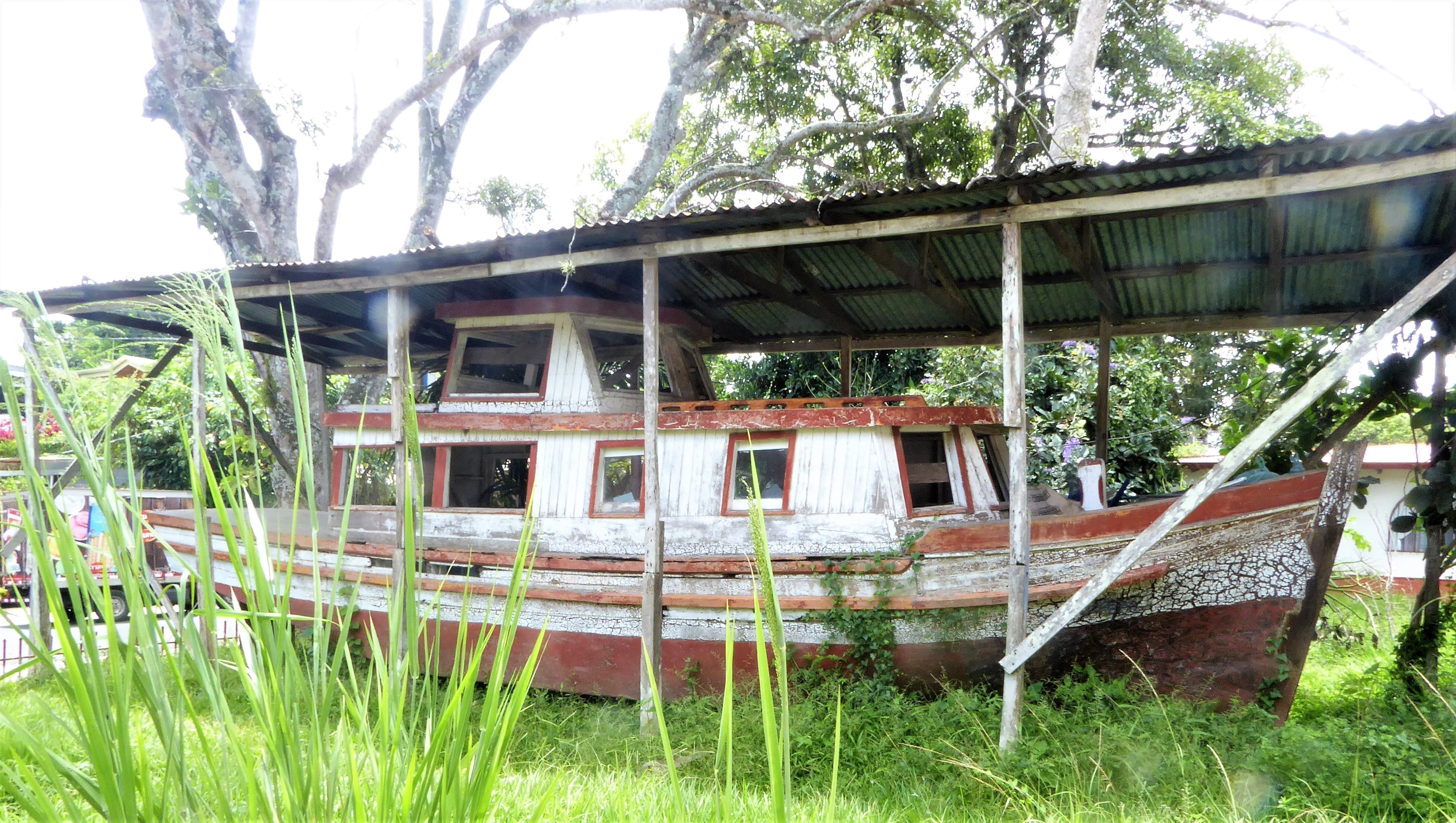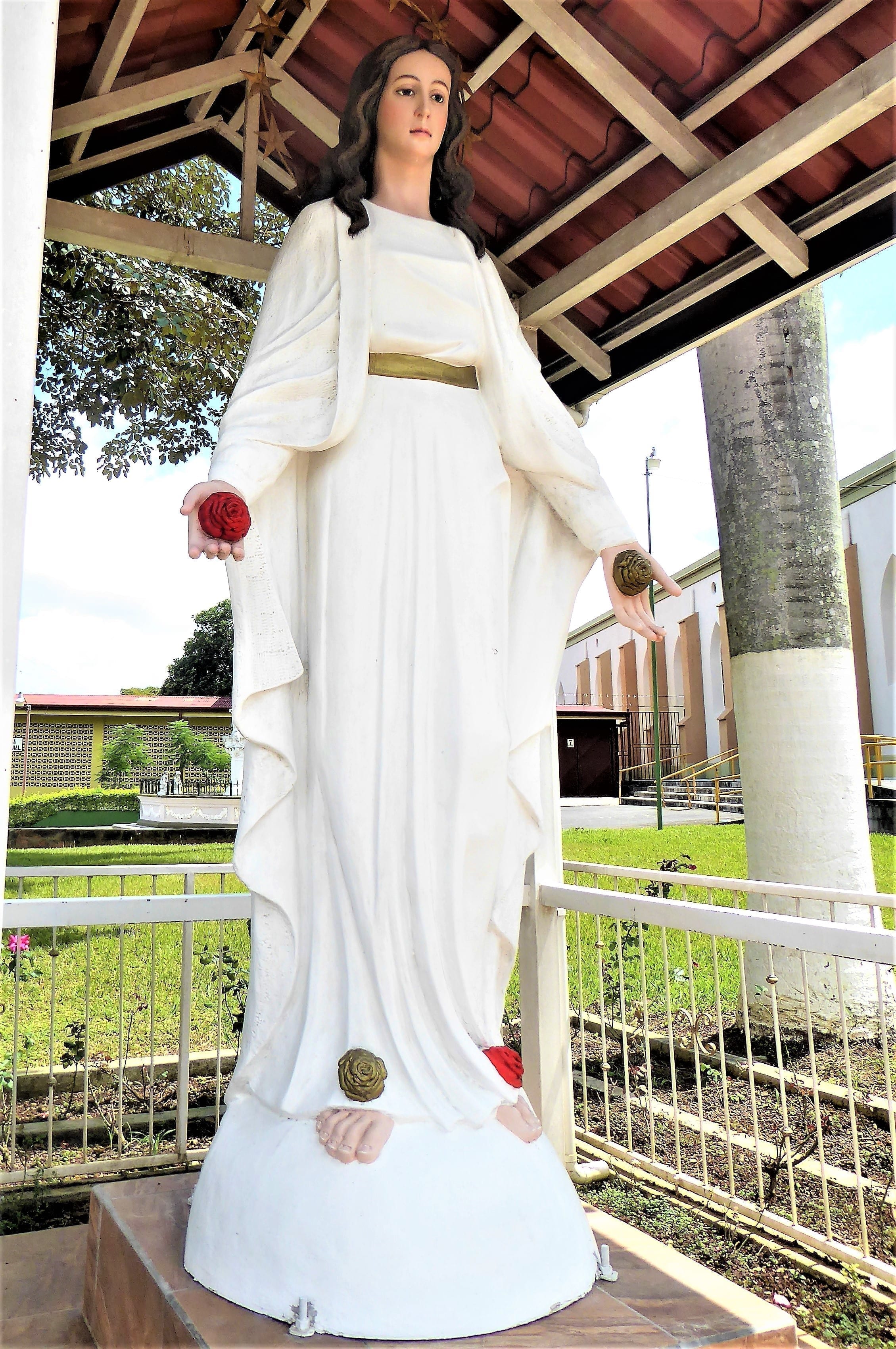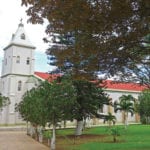
Legends of Atenas
A legend is a folktale, often historically grounded, that changes with each “I swear this is true” retelling. Small towns, by their very gossipy nature, support legends. Over the years, the origins of a tale blurs as it is woven into the fabric of the community.
Atenas, a town in the Central Valley of Costa Rica, has its share of curiosities. There is a road named White Naked Man Curves, and a rickety boat that is permanently moored in a front yard. Once, a worshiper was killed by a falling object from the church tower. Another more recent curiosity is a Madonna statue, recently installed outside San Rafael Church, that has enormous feet.
With a bit of sleuthing, and the help of Marietta Arce and Maricela Soto who are experts on the town, the following is offered to clarify and edify several urban myths about Atenas.
White Naked Man Road
The odd name of an infamous road, Las Vueltas del Macho Chingo or White Naked Man Curves, is based on a story told by an infamous gossip who everyone called Nacho. One day in a barrio of Atenas known as Rio Grande, Nacho shared a story with a friend who was sitting on a park bench. Nacho’s father, who he affectionately called Tata, was known for being quite fond of women and of more than a few drinks.
Nacho said to his friend, “I have to tell you what happened to my old man last night after he left his mistress’s house in Rio Grande. On the way home on the curvy road, he heard some footsteps. He was so frightened that he trembled. Finally, he turned around and saw a huge man, of fair skin and naked except for a tie around his neck. The large menacing man — if he was a man — was levitating above the ground and had eyes that shone. Tata wanted to run away but was so frightened that he couldn’t move.
“He blessed himself on the forehead and in an effort to ward off evil, shouted the Magnificat, a prayer to the Virgin Mary. The naked menace raised a hatchet and threw it against the ground. Tata was terrified that he was about to lose his life. Expecting to be decapitated, he closed his eyes and repeated the Lord’s Prayer. When he next opened his eyes, the shadowy man was retreating, shouting, ‘Just wait. I’ll be back.’ At that point, Tata fainted.
“Around the time the sun rose, Manuel happened by in his oxcart. Seeing Tata on the ground, Manuel rescued him and returned him to my mother. When she saw him, she knew that something terrible had happened to her shameless husband. She said, ‘Those who are into mischief always get taken by the devil.’”
To this day, few venture out alone on the Rio Grande road after dark. People still say, perhaps not realizing why, “I’ll never be crazy enough to go through the Las Vueltas del Macho Chingo at night!”
No doubt, this story has an element of truth to it. This segment of the road contains a series of hairpin turns. It is easy to imagine two inebriated men, one Tico and one gringo, each recalling their encounter through the woozy eyes of an inebriate.
The tale is credited to Maria del Rosario Rojas Venegas de González’s book, Atenas: Recuerdos de Antaño.

Parishioner Felled by Part of a Church Clock
One of the most unusual deaths in Atenas is still a part of the town lore.
The clock that hangs in the tower of San Rafael Catholic Church accurately chimes the time to those in the park across the street and to most of the town. Every hour and half hour, Atenas citizens can rely on the bell announcing the time.
On November 26, 2006, a large section of the century-old clock fell and killed a parishioner. Doña Virginia Ramos, 73, was taken to Mexico Hospital in San José where she seemed to be healing. She suffered a relapse in late December and died.
Doña Ramos had been waiting for her husband outside the main entrance before entering mass when a metal portion of the tower clock that weighed 15 kilos dropped on her. The mechanism that winds the clock exited through the wooden platform and the roof, hitting her head and fracturing one of her arms. The part was made in Europe and installed in the bell tower in 1906.
Doña Ramos was a faithful congregant who was devoted to her community. Her funeral filled San Rafael Church with so many mourners that some had to stand outside. Her family did not fault the church.
Her husband, who had been married to her for 52 years at the time of her death, told La Nación, “The only thing I have left is a thank you for the many people who joined us at the funeral. It was a burial unlike anything we have ever seen here.”
RIP Doña Virginia Ramos.

Madonna with EEEE Feet
In Atenas, a statue of the Virgin of the Roses rests in a barred enclosure, just outside San Rafael Catholic Church. To honor her name, she has a rose on each hand and each foot. Her most distinct feature are enormous feet that are out of proportion to the rest of her.
If the Virgen de las Rosas could speak, she’d tell you that a beloved former priest in Atenas, Father Fabio Blanco Cubillo, was her inspiration. He wanted the patron saint of families and youth to greet visitors as they came into or exited the town. To fulfill his vision, Father Fabio and some congregants searched for and later chose sculptors from the prestigious Zúñiga family to create the Virgin. A number of talented hands were enlisted, including Orlando Carranza, whose works are displayed throughout Atenas. Now deceased, Orlando was a young student studying with the Zúñigas at the time that he helped sculpt the statue.
As for a desirable location, Father Fabio approached a faithful member, Mrs. Amelia Vargas, who owned Cerro Pelon, a lofty hill and pasture above Route 3 in the barrio of Los Angeles. After she agreed, a base for the 3.5- meter Virgin was constructed by volunteers from the county, and the Virgin was transported to what was to become the new home for the Virgin of the Roses. The completed Virgen de los Rosas was installed on May 12, 1985.
The care of a religious icon is no small responsibility. Yearly, the faithful were allowed on the private property to pay homage to her on feast days. Typically a mass was held outdoors as well as a picnic. The Virgin required lighting at night and security. In 1986, the church, with Father Fabio’s blessing, formed a committee to help preserve and maintain the icon and surrounding area.
For 33 years, she served as a landmark above the road from La Garita into Atenas, often the reference point needed to pinpoint an address. Besides the faithful, she had other visitors who climbed the fence and tried to steal the electric cable that illuminated her at night. Vandals damaged her extremities — her feet and hands — which on any statue are vulnerable to weather, erosion, or vandalism.
Eventually in 2018, the Virgin was returned to San Rafael, the church that had commissioned and owned her. Her base had suffered much damage and one hand was missing. The original sculptors were no longer available, so different artisans were enlisted.
She was refurbished and painted before finding her new home outside San Rafael Archangel Catholic Church. Carrying forth the theme of her name, roses have been planted around her. She has a new fashion-forward belt, and her face, hands and feet have been refreshed with painting.
Virgen de los Rosas now has enormous feet and one hand that appears larger than the other. No matter, though. A lady who has endured being revered and reviled, as well as being relocated, deserves a sturdy base upon which to stand.
Click to discover

Noah’s Ark Moored in a Yard
Many years ago, Don Rolando Rojas Sanchez owned a coffee plantation on what is now Calle 2. Today, this bustling street leads to the Mercado Central de Atenas and the red taxi stands in the heart of Atenas. Sprinkled among the businesses that include some popular eateries are a few houses and apartments. In one of the yards is a permanently secured boat that has never been to sea.
Don Sanchez is the owner of the boat and of the coffee brand Café Caucel. His company has over 60 years of history of coffee production, mostly for export. His fields near the barrio of San Isidro still grow coffee.
In the 1960s, coffee flourished throughout Costa Rica. Even until the 1970s, much of San José including Escazú, was a lush, green expanse of coffee fields. Atenas was and is still known for its coffee.
In those halcyon days, among his properties Don Rolando grew coffee on what would become the center of town. The coffee barons of that era purchased his coffee to export and meet the appetite of foreigners who relished Costa Rican coffee.
For relaxation and as a break from planting and harvesting, Don Rolando and his friends enjoyed fishing from small boats and canoes. Occasionally the rich coffee tycoons would invite him to fish with them on their yachts. A dream began for him to own his own boat since his crops were healthy and production was hearty. He’d start with a smaller vessel and perhaps graduate to a larger one with a real motor to take his friends out to fish. He hired some boat makers with the intention of financing the project over time. These artisans had other occupations, so in their spare time they began to construct his boat that was to be christened El Don Melcochas. Alas, that never happened.
In the late ‘70s, coffee prices tumbled at a time when the fields were felled by a fungus called coffee leaf rust. Don Rolando’s boat, like his fortunes, suffered. Work on the boat stopped. Now 88, Don Rolando would like to see the boat launched, but he feels he is too old, and his son has no interest in the project.
Today, the boat has found a permanent mooring place and serves as an odd landmark. The motor is still intact, and renters on his property have accepted El Don Melcochas as a lawn ornament.

